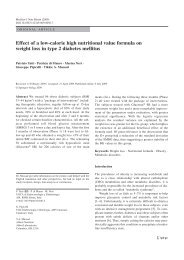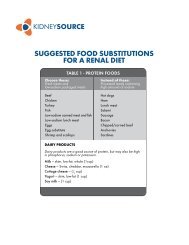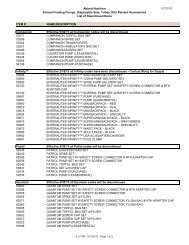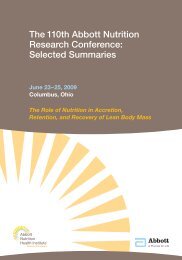Cover Introduction ProSure Clinical Studies ... - Abbott Nutrition
Cover Introduction ProSure Clinical Studies ... - Abbott Nutrition
Cover Introduction ProSure Clinical Studies ... - Abbott Nutrition
You also want an ePaper? Increase the reach of your titles
YUMPU automatically turns print PDFs into web optimized ePapers that Google loves.
<strong>Cover</strong>Definition and classification of cancer cachexia: an international consensusFearon K, Strasser F, Anker SD, Bosaeus I, Bruera E, Fainsinger RL, Jatoi A, Loprinzi C, MacDonald N, Mantovani G, Davis M, Muscaritoli M,Ottery F, Radbruch L, Ravasco P, Walsh D, Wilcock A, Kaasa S, Baracos VE Lancet Oncol. 2011 May;12(5):489-95<strong>Introduction</strong><strong>ProSure</strong><strong>Clinical</strong> <strong>Studies</strong>SupportingPublicationsA group of experts in clinical cancer cachexia (medical and surgicaloncologists, palliative medicine specialists, and nutritionists)participated in a formal consensus process to develop a definition andclassification of cancer cachexia.Definition:Cancer cachexia is a multifactorial syndrome defined by anongoing loss of skeletal muscle mass (with or without loss of fatmass) that cannot be fully reversed by conventional nutritionalsupport and leads to progressive functional impairment. Thepathophysiology is characterised by a negative protein and energybalance driven by a variable combination of reduced food intakeand abnormal metabolism.Diagnosis of cancer cachexia:• Weight loss >5% over 6 months, or• BMI 2%, or• Appendicular skeletal muscle index consistent with sarcopenia(males 5%• BMI 2% or sarcopenia andweight loss > 2%• Reduced food intake/systemic inflammationRefractory cachexia• Varying degrees of cachexia• Procatabolic cancer disease not responsive to treatment• Low performance score• < 3 months life expectancyEPA -eicosapentaenoic acid
















